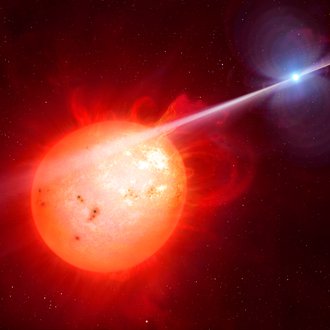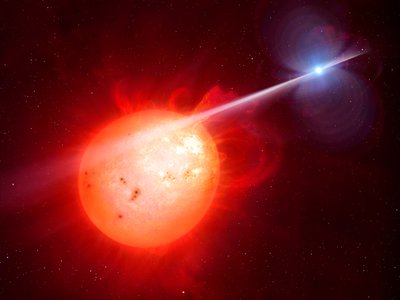Discovery of white dwarf pulsar sheds light on stellar evolution

Artist's impression of a white dwarf pulsar. In this binary star system, a rapidly spinning white dwarf (right) accelerates electrons to nearly the speed of light. These high-energy particles produce bursts of radiation that strike the accompanying red dwarf star (left), causing the entire system to pulsate from the radio to the X-ray range.
Credit: M. Garlick/University of Warwick/ESOThe discovery of a rare type of star system in two independent studies by the University of Warwick and the Leibniz Institute for Astrophysics Potsdam (AIP) provides new insights into the dynamo model’s predictions for stellar evolution. The new white dwarf pulsar, an extremely close binary system of a white dwarf star and a red dwarf star that together would fit inside the Sun, is only the second known of its kind.
White dwarfs are extremely dense stellar remnants with the mass of our Sun but the small size of our planet Earth. They are formed when a low-mass star has burned up all its fuel, loses its outer layers and its interior contracts strongly. They are also called “stellar fossils” and offer insights into various aspects of stellar evolution.
Pulsars, on the other hand, have been known since the 1960s and more than 3000 have been found. They are rapidly rotating, strongly magnetic neutron stars in which charged particles are torn from the surface by ultra-strong electric fields and then accelerated to almost the speed of light. As a result, they emit radiation, i.e. light, in the radio to the X-ray or even gamma range. Due to the fast rotation of the stars, short pulses of radiation arrive at the Earth, which is the reason for their name – pulsar.
To the great surprise of the scientific community, the pulsar phenomenon was observed for the first time on a white dwarf in 2016. The surprise lay in the fact that in this star, AR Scorpii, neither the extremely fast rotation nor the strong electric fields of actual pulsars were present. The white dwarf star, however, was found in a very close binary system and was supplied with particles by its immediate neighbour, a Sun-like red dwarf star, by injection into its magnetic field. This ignites the pulsar phenomenon from the outside and irradiates the red companion star as if with a stroboscope, causing the entire system to become dramatically brighter and fainter at regular intervals. The two stars, the white dwarf and the red dwarf, are so close together that they would fit inside our Sun.
The decisive factor is the presence of a strong magnetic field, the cause of which, however, astrophysicists do not know. A key theory that explains the strong magnetic fields is the “dynamo model”, which says that white dwarfs have dynamos, electrical generators, in their core, just like the Earth, only much stronger. But to test this theory, researchers had to look for other white dwarf pulsars to see if their predictions were correct.
In two new studies published in parallel in Nature Astronomy and Astronomy & Astrophysics, an international team with AIP participation describes the newly discovered white dwarf pulsar J1912-4410 (eRASSU J191213.9-441044). It is 773 light years away from Earth and rotates once on its own axis in five minutes, 300 times faster than our planet. The white dwarf pulsar has a similar size to the Earth, but a mass at least as large as that of the Sun. This means that a teaspoon of white dwarf would weigh about 15 tonnes. White dwarfs begin life at extremely high temperatures before cooling over billions of years. The low temperature of J1912-4410 indicates that it is very old.
The study confirms that there are more white dwarf pulsars, as predicted by earlier models. There were other predictions from the dynamo model that were confirmed by the discovery of J1912-4410. Because of their great age, the white dwarfs in the pulsar system should be cool. Their companions should be close enough that the white dwarf’s gravitational pull in the past was strong enough to extract mass from the companion, causing them to spin rapidly. All of these assumptions hold true for the newly discovered pulsar: the white dwarf is cooler than 13,000 Kelvin, has a high rotation frequency of about five minutes, and the white dwarf’s gravitational pull has a strong effect on the companion.
One team used data from Gaia and WISE to find candidates, focusing on those with similar properties to AR Scorpii. After observing a few dozen candidates, they found one with very similar light variations. A follow-up observation with other telescopes revealed that this system sends a radio and X-ray signal towards Earth about every five minutes. Another team used data from the eROSITA X-ray telescope on the Spectrum-X-Gamma satellite to find close white dwarf/red dwarf pairs. Both teams joined forces to further investigate their new discovery.
“We are very pleased to have found the object in the X-ray survey conducted with SRG/eROSITA,” notes Dr Axel Schwope, head of the X-ray Astronomy group at AIP and first author of the study published in Astronomy & Astrophysics. “The follow-up survey with ESA’s XMM-Newton satellite showed the pulsations in the high-energy X-ray region, the last missing piece of evidence to identify the object as a white dwarf pulsar. This confirmed the unusual nature of the new object and established white dwarf pulsars as a new class, albeit with currently only two members.”
Dr Ingrid Pelisoli from the Department of Physics at the University of Warwick and first author of the Nature Astronomy study, adds: “The origin of magnetic fields is a big open question in many fields of astronomy, and this is particularly true for white dwarf stars. The magnetic fields in white dwarfs can be more than a million times stronger than the magnetic field of the Sun, and the dynamo model helps to explain why. The discovery of J1912−4410 provided a critical step forward in this field.”
Further information
Originalveröffentlichungen
X-ray properties of the white dwarf pulsar eRASSU J191213.9−441044. A. Schwope, T. R. Marsh, A. Standke, I. Pelisoli, S. Potter, D. Buckley, J. Munday, V. Dhillon. A&A 674 L9 (2023)
https://www.aanda.org/articles/aa/abs/2023/06/aa46589-23/aa46589-23.html
DOI: https://doi.org/10.1051/0004-6361/202346589
Pelisoli, I., Marsh, T.R., Buckley, D.A.H. et al. A 5.3-min-period pulsing white dwarf in a binary detected from radio to X-rays. Nat Astron (2023).
Images
Artist's impression of a white dwarf pulsar. In this binary star system, a rapidly spinning white dwarf (right) accelerates electrons to nearly the speed of light. These high-energy particles produce bursts of radiation that strike the accompanying red dwarf star (left), causing the entire system to pulsate from the radio to the X-ray range.
Big screen size [1000 x 749, 70 KB]
Original size [4000 x 2999, 620 KB]



